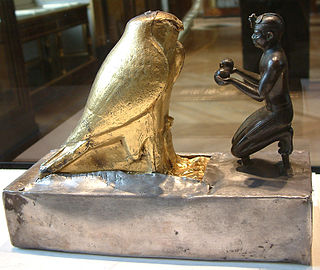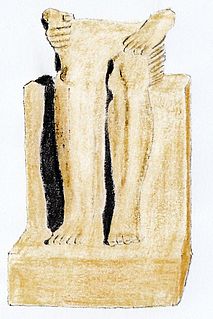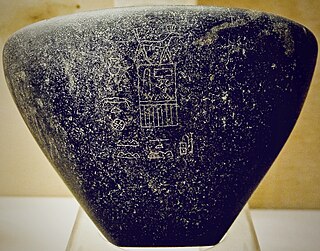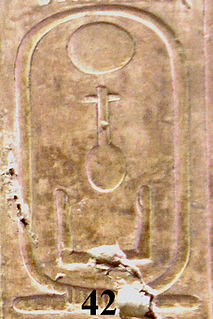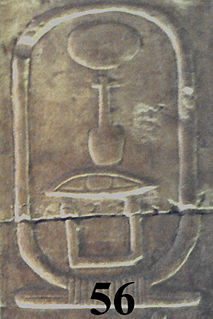| Neferkare VII | ||||||||||||||||||||||||
|---|---|---|---|---|---|---|---|---|---|---|---|---|---|---|---|---|---|---|---|---|---|---|---|---|
| Neferkare VII, Kaneferre(?) | ||||||||||||||||||||||||
| Pharaoh | ||||||||||||||||||||||||
| Reign | c. 2140 BCE (9th Dynasty) | |||||||||||||||||||||||
| Predecessor | Meryibre Khety (not directly) | |||||||||||||||||||||||
| Successor | Nebkaure Khety | |||||||||||||||||||||||
| ||||||||||||||||||||||||
Neferkare VII was the third pharaoh of the ninth Dynasty of ancient Egypt, ca. 2140 BCE (during the First Intermediate Period), according to the Turin King List where his name, Neferkare, is inscribed in the register 4.20.
Neferkare is not included on the Abydos King List or the Saqqara King List , nor can the existence of his reign be positively confirmed through archaeological finds.

Pharaoh is the common title of the monarchs of ancient Egypt from the First Dynasty until the annexation of Egypt by the Roman Empire in 30 BCE, although the actual term "Pharaoh" was not used contemporaneously for a ruler until Merneptah, c. 1200 BCE. In the early dynasty, ancient Egyptian kings used to have up to three titles, the Horus, the Sedge and Bee (nswt-bjtj) name, and the Two Ladies (nbtj) name. The Golden Horus and nomen and prenomen titles were later added.
The Ninth Dynasty of ancient Egypt is often combined with the 7th, 8th, 10th and early 11th Dynasties under the group title First Intermediate Period. The dynasty that seems to have supplanted the 8th Dynasty is extremely obscure. The takeover by the rulers of Herakleopolis was violent and is reflected in Manetho's description of Achthoes, the founder of the dynasty, as 'more terrible than his predecessors', who 'wrought evil things for those in all Egypt".

Ancient Egypt was a civilization of ancient North Africa, concentrated along the lower reaches of the Nile River in the place that is now the country Egypt. Ancient Egyptian civilization followed prehistoric Egypt and coalesced around 3100 BC with the political unification of Upper and Lower Egypt under Menes. The history of ancient Egypt occurred as a series of stable kingdoms, separated by periods of relative instability known as Intermediate Periods: the Old Kingdom of the Early Bronze Age, the Middle Kingdom of the Middle Bronze Age and the New Kingdom of the Late Bronze Age.
The praenomen "Neferkare" suggests he considered himself a legitimate successor of Pepi II Neferkare of the Sixth Dynasty, much like the many namesake Memphite kings of the Eighth Dynasty. In some literature he is called "Neferkare VII" because he likely was the seventh king to bear this name, although many of his predecessors are now called by a combination of their praenomen and nomen (for example, Neferkare Neby, or Neferkare Pepiseneb).

Pepi II was a pharaoh of the Sixth Dynasty in Egypt's Old Kingdom who reigned from c. 2278 BC. His throne name, Neferkare (Nefer-ka-Re), means "Beautiful is the Ka of Re". He succeeded to the throne at age six, after the death of Merenre I.

Memphis was the ancient capital of Aneb-Hetch, the first nome of Lower Egypt. Its ruins are located near the town of Mit Rahina, 20 km (12 mi) south of Giza.
The Eighth Dynasty of ancient Egypt is a poorly known and short-lived line of pharaohs reigning in rapid succession in the early 22nd century BC, likely with their seat of power in Memphis. The Eighth Dynasty held sway at a time referred to as the very end of the Old Kingdom or the beginning of the First Intermediate Period. The power of the pharaohs was waning while that of the provincial governors, known as nomarchs, was very important, the Egyptian state having by then effectively turned into a feudal system. In spite of close relations between the Memphite kings and powerful nomarchs, notably in Coptos, the Eighth Dynasty was eventually overthrown by the nomarchs of Heracleopolis Magna, who founded the Ninth Dynasty. The Eighth Dynasty is sometimes combined with the preceding Seventh Dynasty, owing to the lack of archeological evidence for the latter which may be fictitious.
This otherwise unattested ruler of Herakleopolis Magna has been controversially identified by various scholars with a king named Ka-nefer-re, who is mentioned in an obscure and isolated tomb inscription of Ankhtifi, the pro-Herakleopolite nomarch of Hieraconpolis and prince of El-Mo'alla, about 30 km (19 mi) south of Thebes.
If Neferkare and Kaneferre were the same pharaoh, his authority is sometimes presumed from Ankhtifi's inscription to have extended at least over Elephantine, Edfu and Hieraconpolis, the capitals of the first three nomoi of Upper Egypt. However, the inscription in question simply states "Horus brings/brought (or may Horus bring) a (good) inundation for his son Ka-nefer-Re." Uncertainty about the verb tense in the inscription has led to disagreement among various scholars as to whether this named pharaoh would have ruled in Ankhtifi's youth, or at the time of the events he describes, or indeed if it were not a king before Ankhtifi's time, who had ruled toward the end of the Old Kingdom from Memphis.
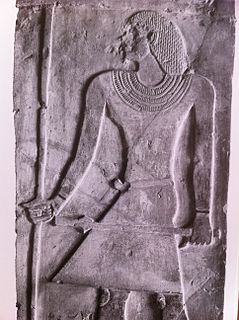
Ankhtifi was a nomarch of Hierakonpolis and a supporter of the pharaoh in Herakleopolis Magna, which was locked in a conflict with the Theban based 11th Dynasty kingdom for control of Egypt. Hence, Ankhtifi was possibly a rival to the Theban rulers Mentuhotep I and Intef I. He lived during the First Intermediate Period, after the Egyptian Old Kingdom state had collapsed, and at a time when economic hardship, political instability, and foreign invasion challenged the fabric of Egyptian society.
Nomarchs were Ancient Egyptian administration officials responsible for the provinces. Effectively serving as provincial governors, they each held authority over one of the 42 nomes into which the country was divided. Nome is derived from the Greek nomos, meaning a province or district, and nomarch is derived from the Greek title nomarches, the ruler of a nomos.

Thebes, known to the ancient Egyptians as Waset, was an ancient Egyptian city located along the Nile about 800 kilometers (500 mi) south of the Mediterranean. Its ruins lie within the modern Egyptian city of Luxor. Thebes was the main city of the fourth Upper Egyptian nome and was the capital of Egypt mainly during the Middle Kingdom and the New Kingdom. It was close to Nubia and the Eastern Desert, with its valuable mineral resources and trade routes. It was a cult center and the most venerated city of ancient Egypt during its heyday. The site of Thebes includes areas on both the eastern bank of the Nile, where the temples of Karnak and Luxor stand and the city proper was situated; and the western bank, where a necropolis of large private and royal cemeteries and funerary complexes can be found.

